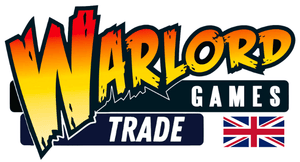Products
-
Japanese Special Naval Landing ForceThe Japanese Special Naval Landing Forces (SNLF) were the marine troops of the Imperial Japanese Navy. Due to the deep distrust the Japanese Army and Navy had for each other, joint operations were all but out of the question and the Navy created the...
-
Japanese Support GroupThe men of the Imperial Japanese Army were excellent soldiers, with extraordinary devotion to their country and their Emperor. Battle-hardened by years of war in Manchuria, the Japanese army was well-disciplined, led by seasoned officers, and watched over by the dreaded Kempei-tei political officers....
-
Japanese Teishin Shudan Paratrooper SquadJapanese paratroopers – Teishin Shudan (raiding group) – proved highly effective in the early years of the war. German successes with paratroops during 1940 encouraged the Japanese to develop their airborne arm as a constituent part of the Imperial Japanese Army Air Force (IJAAF)....
-
Japanese Type 4 Ho-Ro self-propelled gunInspired by German self-propelled guns the Type 4 Ho-Ro assault gun was based on a reinforced Type 97 Chi-Ha tank chassis. The Type 4 Ho-Ro mounted the Type 38 150mm howitzer. Surrounding the front of the howitzer was 25mm of armour plating – the...
-
Japanese Type 92 70mm infantry gunPack contains 1 metal gun and 3 metal foot figures Note: Models supplied unassembled and unpainted
-
Japanese Type 95 Ha-Go light tankThe Type 95 Ha-Go light tank was the most numerous armoured fighting vehicle fielded by the Japanese during WWII. It also saw action against the Soviet Union at Khalkhin Gol in 1939 and during the Sino-Japanese war of 1937-45. It saw action in both Imperial...
-
King TigerThe Königstiger (officially named the Panzerkampfwagen Tiger Ausf. B or Sd.kfz 182) more commonly known as the ‘King Tiger’ or ‘Royal Tiger’ by Allied troops, was a development of the fearsome Tiger I tank. Its introduction to hostilities in 1944 caused significant problems for...
-
Kriegsmarine SquadThe men of the Kriegsmarine were often asked to do more than serve at sea. U-Boat and ship crews could be found in land actions in many theatres, wearing their trademark blue sailor’s uniforms or the grey-blue U-Boat leathers as they took the fight...
-
KV1/2 Plastic Box SetThe KV1/2 plastic box is absolutely crammed packed with the might of mother Russia: Enough plastic components to create one tank body and both complete turret variants (KV-1 turret and KV-2 turret)! A detailed construction booklet. A set of full-colour waterslide decals to allow...
-
Luftwaffe Field Division 88mm Flak 37Originally developed as an anti-aircraft weapon, the Flak 37 8.8cm (or Eighty-eight as it became known by Allied troops) had a high muzzle velocity to allow it to reach the higher ranges modern bombers were capable of at the time. This would make it an...
-
Luftwaffe Field Division SquadAfter the the initial spectacular success of the German invasion of Russia in 1941 the invasion slowed to a crawl as the weather and hard fighting ground down their formations. Desperate to shore up the front seven regiments were formed of non-flying personnel taken...
-
M10 Tank Destroyer Platoon (plastic)Based on the proven and numerous M4 Sherman chassis, the M10 was fielded in large numbers during WWII. Although it would be replaced by other tank destroyers based on the same design the M10 continued to serve to the war's end with distinction, serving...
-
M10 Tank Destroyer/Wolverine (Plastic Box)The M10's M7 3-inch (76.2mm) anti-tank gun was a considerable improvement over the 75mm carried by the Sherman. The M10’s relatively thin 37mm of armour (and open-topped five-sided welded turret) on the other hand made it vulnerable to anti-tank weapons, so its main role...
-
M18 HellcatThe Hellcat’s prodigious speed was attained by keeping it’s armour to no more than 1″ thick. Hellcat crews quickly took advantage of the vehicle’s speed to minimise the enemy’s ability to pierce its thin armour. Hellcats used their speed to outflank and penetrate the...
-
M21 Mortar Carrier Half-trackBringing support fire to your mobile forces with the M21 Mortar carrier, ideal for winkling out those dug in infantry! By the middle of the war the US Army could field legions of tanks and support vehicles, backed by the industrial might of the USA....
-
M24 Chaffee, US light tankInitially produced as a replacement for the M3/M5 Stuart light tanks, the armour of the M24 was purposely kept light, with a glacis plate only 25mm thick (although its heavy slope increased its effectiveness). A vastly upgraded lightweight 75mm gun (compared to the 37mm...
-
M26 Pershing heavy tankThe M26 Pershing was the first truly heavy tank to see service in the American army. It was designed to be a replacement for the backbone of the US Armoured Divisions, the M4 Sherman – a good all-round medium tank that gave sterling service...
-
M3 Grant (Western Desert)The Medium Tank M3 was an American tank used by the British, US and Soviet forces. British troops gave nicknames to US tanks to avoid the confusion caused by the US military coding system. The original M3 became known as the Lee and the...
-
M3 StuartAs American tank designers began to recognise the outdated and obsolete nature of the M2 light tank, they realised they needed to create something new. The M3 Stuart was a direct upgrade from its predecessor, the M2 light tank, with thicker armour, modified suspension...
-
M3 Stuart PlatoonBefore the war much effort went into building light tanks, which were felt to have a role analogous to cavalry in an earlier age. Once war began these precepts were quickly brought into question, and the need for more heavily armoured and better armed...








































